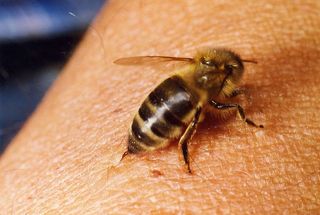
For most of his life, my friend Dick Nunamaker has kept bees. In effect, he began by using cognitive behavioral therapy to avoid developing a fear of them, rather than to treat a phobia. Before setting up his own hives, he listened to experienced apiculturalists, read dozens of books, and imagined every step he needed to take with the bees (a standard technique in systematic desensitization). So when he was stung as a new beekeeper, the cognitive model worked against conditioning a fearful response. At least for Dick, the risk of being stung does not evoke anxiety but provides a paradoxical source of calm.
Dick describes beekeeping as a kind of therapy, a refuge from problems and worries. He eschews protective equipment to keep open the potential for being stung. It is precisely this possibility that requires him to be fully in the moment. If his attention wanes, the insects provide a sharp reminder to pull him back into the flow. So for Dick, a bee yard is a kind of sanctuary, an unexpectedly peaceful place where anxiety dissolves.
Having worked with bees and interacted with the public for decades, Dick has some valuable insights as to the origins of apiphobia (the fear of bees). The strands that run through nearly everyone’s fear are socialization, pain, and death. In terms of socialization, Hollywood set the stage for fear with The Deadly Bees (1966) and The Swarm (1978)—and newspaper headlines declared “Experts Say ‘Killer Bees’ to Reach US this Spring” in 1990. As for pain, it hurts to be stung (that being the point from the bee’s perspective), but Dick describes the experience as being “not nearly as bad as hitting my thumb with a hammer.” With respect to death, bees kill more people in the U.S. than any other animal, but less than 1 percent of people are allergic to their stings (the public falsely believes this to be 50 percent).
People often stop to watch Dick work his hives. They call out, "Aren't you afraid?" but then see this jovial fellow dressed in shorts and a T-shirt calmly moving among the insects without being harmed. As with cognitive behavioral therapy, the empirical data are contrary to their hypothesis of danger. And the bees aren’t coming after them either. Firsthand experiences begin to undermine irrational fear.
While modeling nonfearful behavior can function as a cognitive vaccination against incipient phobias, Dick also taps into what psychologists would recognize as systematic desensitization. He invites visitors to draw closer, methodically approaching the hives and becoming comfortable with each step. And when they find themselves amidst the bees, they are delighted—and so is Dick.
He tells them that the insects do not warrant fear, but they deserve respect. Dick leaves the extermination of apiphobia to the experts. His goal is to help people avoid developing an infested mind.


